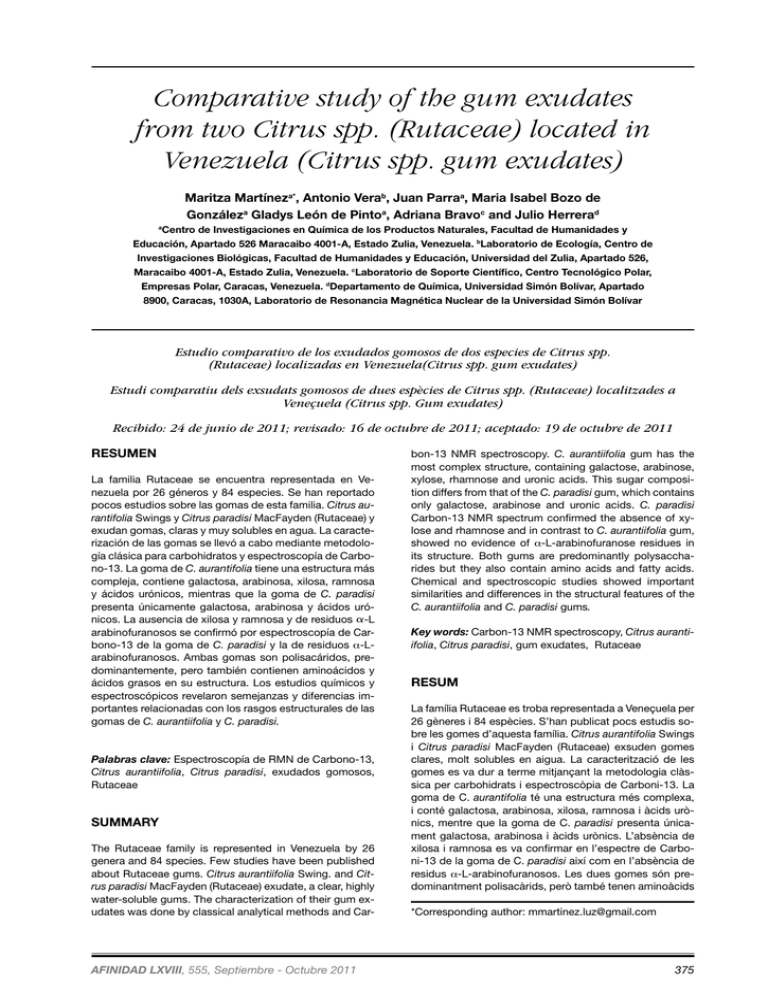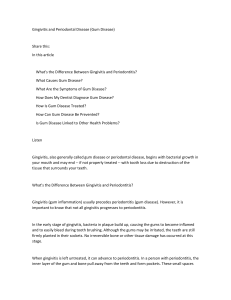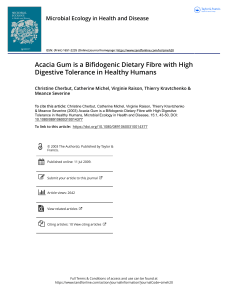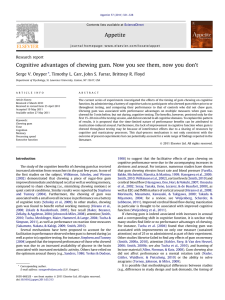Citrus spp. gum exudates
Anuncio

Comparative study of the gum exudates from two Citrus spp. (Rutaceae) located in Venezuela (Citrus spp. gum exudates) Maritza Martíneza*, Antonio Verab, Juan Parraa, Maria Isabel Bozo de Gonzáleza Gladys León de Pintoa, Adriana Bravoc and Julio Herrerad Centro de Investigaciones en Química de los Productos Naturales, Facultad de Humanidades y Educación, Apartado 526 Maracaibo 4001-A, Estado Zulia, Venezuela. bLaboratorio de Ecología, Centro de Investigaciones Biológicas, Facultad de Humanidades y Educación, Universidad del Zulia, Apartado 526, Maracaibo 4001-A, Estado Zulia, Venezuela. cLaboratorio de Soporte Científico, Centro Tecnológico Polar, Empresas Polar, Caracas, Venezuela. dDepartamento de Química, Universidad Simón Bolívar, Apartado 8900, Caracas, 1030A, Laboratorio de Resonancia Magnética Nuclear de la Universidad Simón Bolívar a Estudio comparativo de los exudados gomosos de dos especies de Citrus spp. (Rutaceae) localizadas en Venezuela(Citrus spp. gum exudates) Estudi comparatiu dels exsudats gomosos de dues espècies de Citrus spp. (Rutaceae) localitzades a Veneçuela (Citrus spp. Gum exudates) Recibido: 24 de junio de 2011; revisado: 16 de octubre de 2011; aceptado: 19 de octubre de 2011 Resumen La familia Rutaceae se encuentra representada en Venezuela por 26 géneros y 84 especies. Se han reportado pocos estudios sobre las gomas de esta familia. Citrus aurantifolia Swings y Citrus paradisi MacFayden (Rutaceae) y exudan gomas, claras y muy solubles en agua. La caracterización de las gomas se llevó a cabo mediante metodología clásica para carbohidratos y espectroscopía de Carbono-13. La goma de C. aurantifolia tiene una estructura más compleja, contiene galactosa, arabinosa, xilosa, ramnosa y ácidos urónicos, mientras que la goma de C. paradisi presenta únicamente galactosa, arabinosa y ácidos urónicos. La ausencia de xilosa y ramnosa y de residuos -L arabinofuranosos se confirmó por espectroscopía de Carbono-13 de la goma de C. paradisi y la de residuos α-Larabinofuranosos. Ambas gomas son polisacáridos, predominantemente, pero también contienen aminoácidos y ácidos grasos en su estructura. Los estudios químicos y espectroscópicos revelaron semejanzas y diferencias importantes relacionadas con los rasgos estructurales de las gomas de C. aurantiifolia y C. paradisi. bon-13 NMR spectroscopy. C. aurantiifolia gum has the most complex structure, containing galactose, arabinose, xylose, rhamnose and uronic acids. This sugar composition differs from that of the C. paradisi gum, which contains only galactose, arabinose and uronic acids. C. paradisi Carbon-13 NMR spectrum confirmed the absence of xylose and rhamnose and in contrast to C. aurantiifolia gum, showed no evidence of α-L-arabinofuranose residues in its structure. Both gums are predominantly polysaccharides but they also contain amino acids and fatty acids. Chemical and spectroscopic studies showed important similarities and differences in the structural features of the C. aurantiifolia and C. paradisi gums. a Palabras clave: Espectroscopía de RMN de Carbono-13, Citrus aurantiifolia, Citrus paradisi, exudados gomosos, Rutaceae SUMMARY The Rutaceae family is represented in Venezuela by 26 genera and 84 species. Few studies have been published about Rutaceae gums. Citrus aurantiifolia Swing. and Citrus paradisi MacFayden (Rutaceae) exudate, a clear, highly water-soluble gums. The characterization of their gum exudates was done by classical analytical methods and Car- Afinidad LXVIII, 555, Septiembre - Octubre 2011 Key words: Carbon-13 NMR spectroscopy, Citrus aurantiifolia, Citrus paradisi, gum exudates, Rutaceae RESUM La família Rutaceae es troba representada a Veneçuela per 26 gèneres i 84 espècies. S’han publicat pocs estudis sobre les gomes d’aquesta família. Citrus aurantifolia Swings i Citrus paradisi MacFayden (Rutaceae) exsuden gomes clares, molt solubles en aigua. La caracterització de les gomes es va dur a terme mitjançant la metodologia clàssica per carbohidrats i espectroscòpia de Carboni-13. La goma de C. aurantifolia té una estructura més complexa, i conté galactosa, arabinosa, xilosa, ramnosa i àcids urònics, mentre que la goma de C. paradisi presenta únicament galactosa, arabinosa i àcids urònics. L’absència de xilosa i ramnosa es va confirmar en l’espectre de Carboni-13 de la goma de C. paradisi així com en l’absència de residus α-L-arabinofuranosos. Les dues gomes són predominantment polisacàrids, però també tenen aminoàcids *Corresponding author: mmartinez.luz@gmail.com 375 i àcids grassos en la seva estructura. Els estudis químics i espectroscòpics van revelar semblances i diferències importants relacionades amb els trets estructurals de les gomes de C. aurantiifolia i C. paradisi. Paraules clau: Espectroscòpia de RMN de Carboni-13, Citrus aurantiifolia, Citrus paradisi, exsudats gomosos, Rutaceae Introduction Rutaceae, is a wide family which contains about 150 – 160 genera, and 1,600 species in tropical and subtropical countries (Badillo et al. 1985). About 84 species, in 26 genera, have been reported for Venezuela (Hokche et al. 2008). Few studies have been published about Rutaceae gums. The structural features for Feronia elephantum Correa 1800 (Mathur and Mukherjee 1952) and Citrus limonia Osbeck 1765 gum exudates (Stoddart and Jones 1968) have been investigated. Also, the isolation and characterization of five oligosaccharides from Aegles marrmelos (L.) Correa 1800 (bael gum) (Roy et al. 1975) have been described. The analytical data for the gum from Chloroxylon swietenia DC. 1824 (Anderson et al. 1986) as well as the physicochemical, rheological characteristics and emulsification activity of Zanthoxylum tessmanii (Engl.) J. F. Ayafor (syn. Fagara melanorhachis Hoyle1933) have been reported (Orafidiya 1989, Orafidiya et al. 1992a, 1992b). The application of Carbon-13 NMR to Amyris elemifera L. 1759 exudate (Mexican elemi) confirmed its kinos-resinous character (Lambert et al. 2005). Today, there is a growing interest in the study of polysaccharides from sources different to that of the arabic gum (Acacia senegal Willd. 1806) (Anderson et al. 1990). The analytical parameters of these polymers are regarded as a fingerprint of chemo-taxonomic importance (Anderson and Dea 1969). Citrus aurantiifolia (Christm) Swingle 1913 and Citrus paradisi Macfad 1830, species cultivated in Venezuela, excrete a clear, highly water-soluble gums. To date, there are no documented published reports on the gum exudates from these two species. This analysis compares the physochemical properties and spectroscopic features of the gums from these two Citrus species. Materials and methods Origin and purification of gum samples Gum samples were collected in Maracaibo, Venezuela, during January-March, 2010, from cultivated trees of C. aurantiifolia (“limón criollo“) and C. paradisi (“grapefruit”, “toronja roja”). The exudates were collected three weeks after incisions were made on the trunk, to obtain the appropriate yield. The identification of voucher specimens was confirmed by José Grande, plant taxonomist at the Fundación La Salle, Venezuela. Gum samples were purified using methods described previously (León de Pinto 1991). Analytical methods The nitrogen content was determined by Kjeldahl method 376 and the ash cationic composition by atomic absorption spectroscopy. Optical rotation, at equilibrium, was measured at room temperature in a Perkin-Elmer 241 polarimeter, using water diluted (1%) samples. Neutral sugar composition was estimated by the phenol - H2SO4 method (Dubois et al. 1956) and by HPLC, and the uronic acid content by the m-hydroxybiphenyl method (Blumenkrantz and Asboe-Hansen 1973). Absence of D-galacturonic acid was demonstrated by an appropriate solvent system (Kinsley 1967) and a quantitative colorimetric method was used to show presence of tannins (Abed et al. 2003). Intrinsic viscosities were determined by the isoionic method, using an Ubbelode viscosimeter, and amino acid composition by HPLC. The fatty acids contents were determined by GC, after derivatization to methyl esters. NMR Spectroscopy: Carbon-13 NMR and DEPT-135, for both gums, were recorded with a 13C-NMR (Bruker AM 400) spectrometer. Data points (6,000-7,000) were accumulated overnight at 30ºC and with complete proton decoupling. Samples (50 mg) were dissolved completely in D2O (1 mL). Inverted signals in DEPT-135 corresponded to the free or linked hydroxyl primary groups of the sugar residues present in the structure. Results and Discussion The sugar composition of C. aurantiifolia gum, Table 1, differs from that of C. paradisi gum, which contains only galactose, arabinose and uronic acids. Absence of xylose and rhamnose has also been reported for C. swietenia gum (Rutaceae) (Stoddart and Jones 1968). The galactose : arabinose ratio (2 :1), in both cases, was higher than that reported for other Rutaceae (Stoddart and Jones 1968, Anderson et al. 1986) but lower than that described for Meliaceae gums, a related family (Rutales order) (León de Pinto et al. 1996). The acidity content of the C. paradisi gum is higher (37%) than that of C. aurantiifolia., Table 1. The high acidity content has also been reported for gums from Caesalpinaceae (León de Pinto et al. 1993), Combretaceae (León de Pinto et al., 1998) and Sterculiaceae (Larrazábal et al. 2006). The ash contents, Table 2, suggest that these uronic acids are partly neutralized by metals, calcium and sodium predominantly. The low positive specific rotation values shown by both Citrus gums, Table 1, suggest the presence of b- D sugar residues, predominantly in their structure (León de Pinto 1991). The specific rotation is an important commercial parameter used for gum identity and purity criteria (Williams and Phillips 2000). The intrinsic viscosity value for C. paradisi gum was relatively low, Table 1, as it has been reported for Venezuelan Acacia gums, and it may be related to a possible compact structure (Dror et al. 2006). On the other hand, the intrinsic viscosity value for C. aurantiifolia gum was similar to that of A. senegal gum, a hydrocolloid of wide industrial application (Dror et al. 2006). The gum nitrogen content, and therefore the protein content, was very similar for both Citrus species, Table 1, although, their amino acid composition was different, Table 3. Phenylalanine was the main amino acid in C. aurantiifolia gum, Table 3, while hydroxyproline is the major component in C. paradisi gum, as has been reported for many Acacia gums (Beltrán et al. 2005). The participation of the last amino acid in the carbohydrate-protein linkage of a Afinidad LXVIII, 555, Septiembre - Octubre 2011 Table 1. Analytical dataa of C. aurantiifolia and C. paradisi gum exudates Parameter C. aurantiifolia C. paradisi Moisture, % 6.86 3.10 Ash, %a 5.10 7.74 Nitrogen, %a 0.68 0.54 Hence Protein (%N x 6.25)a 4.25 3.40 Specific rotation, º b +9 +24 h (mL/ g) b 22 11 b,c Acidity, % 15 37 Galactose 54 46 Arabinose 25 17 Xylose 2 - Rhamnose 3 - Neutral sugar composition, %b a Average bCorrected for moisture c The acidity is represented by uronic acid residues. Table 2. Cationic composition of C. aurantiifolia and C. paradisi gum exudates. Cations Concentration (ppm) C. aurantiifolia C. paradisi Calcium 23498 22154 Sodium 22334 12112 Magnesium 1727 4088 Potassium 3875 2809 Aluminium 831 902 Vanadium 406 116 Copper 78 45 Lead was detected as traces. Table 3. Amino acid composition of C. aurantiifolia and C. paradisi gum exudatesa Amino acid C. aurantiifolia C. paradisi Asp 0.13 0.05 Glu 0.17 0.06 Hyp 0.62 1.36 Ser 0.18 0.11 Gly 0.10 0.07 His n.d. 0.12 Arg + thre 0.13 0.12 Ala 0.14 0.15 Pro 0.15 0.28 Tyr 0.21 0.20 Val 0.12 0.20 Met 0.22 0.11 Cys Nd Nd Ileu 0.07 0.11 Leu 0.13 0.17 Phe 1.74 0.18 Lys 0.13 0.11 % protein 4.26 3.40 a mg of amino acid/ mg of total sample Afinidad LXVIII, 555, Septiembre - Octubre 2011 377 Figure 1. a) Carbon-13 NMR b) DEPT-135 of C. aurantiifolia gum. At = terminal α-L-arabinofuranose A = 3-O-α-L-arabinofuranose G = 3-O-β-D-galactopyranose R = rhamnose Ue = 4-OMe-α-D-glucuronic acid U = β-D-glucuronic acid X = β-D-xylopyranose . ‘ = carbon involucrated in a linkage Figure 2. a) Carbon-13 NMR b) DEPT-135 of C. paradisi gum. Ap= b-L-arabinopyranose G=3-O-b-D-galactopyranose Ue= 4-OMe-a-D-glucuronic acid. U= β-D-glucuronic acid. ‘ = carbon involucrated in a linkage 378 Afinidad LXVIII, 555, Septiembre - Octubre 2011 due to a methyl group of rhamnose (Larrazábal et al. 2006) and two inverted signals (65.40 and 66.40 ppm) assignable probably to C-5 of b-D-xylopyranose residues (Añez et al. 2007). In the anomeric region (99.00 to 109.49 ppm) there are seven signals which correspond to seven types of linkages. The unequivocal signals, at low field (109.49; 107.66 ppm), are probably due to the C-1 of terminal and 3-O-a-L-arabinofuranose residues, respectively, and are related to C-2 (80.28; 81.12 ppm), free C-3 (76.81 ppm), C-3-linked (82.20 ppm), C-4 (84.28; 82.63 ppm) and C-5 (62.51; 61.51 ppm, inverted DEPT-135) resonances of complex arabinogalactan-protein has been described for other gum exudates (Beltrán et al. 2005). Fatty acids were similar for the two Citrus gums, Table 4: palmitic acid was the main component. Linoleic and linolenic acids were also present in C. aurantiifolia gum. However, the high proportion of saturated fatty acids may confer low nutritional value to these gums. The NMR Carbon-13 and DEPT-135 spectra, for the gum samples, Figures 1 and 2, are according with the chemical data. The DEPT-135 spectrum of C. aurantiifolia, Fig. 1b, showed, at high field, the non-inverted signal (16.76 ppm) Table 4. Fatty acid compositiona of C. aurantiifolia and C. paradisi gum exudates Fatty acid C. auraniitifolia C. paradisi C12:0 31 5.99 C13:0 1.1 1.9 C14:0 4.21 5.6 C16:0 32 45 C16:1n9c 12.9 9.2 C17:0 1.6 4 C18:0 5.8 6 C18:1n9c 7.3 17.2 C18:2n6c 3.4 - 0.39 - C18:3n3 Averages a those residues (León de Pinto et al. 1998). In addition, there were observed signals due to 3-O-b-D-galactose residues, i.e. C-1 (103.38 ppm), C-3-linked (82.63 ppm) and C-6 (60.30 ppm, inverted DEPT-135), sugar present in other Rutaceae gums (Roy et al. 1975). The non-inverted signal (60.12 ppm), due to the methoxyl group, and the corresponding anomeric carbon resonance (99.80 ppm) were assigned to 4-O-methyl-a-D-glucuronic acid (León de Pinto et al. 1998). The signals C-2 (75.68 ppm), C-3 and C-5 (76.81 ppm), due to terminal b-D-glucuronic acid (León de Pinto et al. 1998), were well resolved into the C. aurantiifolia gum spectrum, Figs 1a and 1b. In other hand, the Carbon-13 NMR spectrum of C. paradisi gum, Figs 2a and 2b, contained the resonances due to 3-O-b-D-galactose and 4-O-methyl-a-D-glucuronic acid residues described above for C. aurantiifolia gum. The signals which correspond to the b-D-glucuronic acid are not well differentiated in this spectrum. However, the anomeric region showed an unequivocal resonance assignable to C-1 for these kind of residues (León de Pinto et al. 1998). No anomeric signals were detected, due to a-L-arabinofuranose. Nevertheless, there was observed a signal (100.34 ppm), which may be related to an inverted one, at high field (63.00 ppm), assignable to b-L-arabinopyranose residues (Bock et al. 1984). The signals that appear at low field (176-177 ppm), in both spectra, are assigned to C-6 of the uronic acids, Figs 1 and 2. The absence of a lower field signal (181 ppm) - assignable to carboxylic groups, partly neutralized by metals - suggests that most of these functional groups in the structure of the studied gums are not substituted (Larrazábal et al. 2006). Afinidad LXVIII, 555, Septiembre - Octubre 2011 Conclusions: The chemical and Carbon-13 NMR spectra of the analyzed gums showed that the gum structure of C. aurantiifolia was more complex than that of C. paradisi. C. aurantiifolia gum spectra showed multiple signals attributed to rhamnose, β-D-xylopyranose, terminal and 3-O-α-L-arabinofuranose, 3-O-β-D-galactopyranose, β-D-glucuronic acid and its 4-O-methyl-α-ether while C. paradisi spectra confirmed the absence of xylose and rhamnose and suggested the presence of β-L-arabinopyranose residues, in liu of α-Larabinofuranose, in its structure. Citrus gums showed analytical data which could be applied as criteria for their use on diverse industries. In addition, this work represents a contribution to the study of gum exudates from other genera, different of Acacia, as substitute of gum arabic in its multiple industrial applications. Acknowledgements The authors wish to express herein their gratitude to Universidad del Zulia (C.O.N.D.E.S.) for the financial support received for research projects such as this comparative analysis of gum exudates from species found in Venezuela. BIBLIOGRAPHY 1. Badillo, V. M.; Schnee, L. and Benítez de Rojas, C. 1985. “Clave de las familias de plantas superiores de Venezuela”. Séptima Edición. Espasande, S.R..L. Caracas, Venezuela, 270 p. 379 2. 3. 4. 5. 6. 7. 8. 9. 10. 11. 12. 13. 14. 15. 16. 17. 18. 380 Hokche, O., Berry, P. E.; y Huber, O. (eds). 2008. “Nuevo catálogo de la flora vascular de Venezuela”. Fundación Instituto Botánico de Venezuela “Dr. Tobías Lasser”, Caracas, Venezuela. 859 p. Mathur, G. P. and Mukherjee, S. 1952. “Investigations on the structure of kheta gum (Feronia elephantum: Family Rutaceae)”. J. Sci. Industr. Res. IIB: 544-555. Stoddart, J. F. and Jones, J. K. N. 1968. “Some structural features of Citrus limonia gum (Lemon Gum)”. Carbohydr. Res. 8: 29-42. Roy, A.; Mukherjee, A. K. and Rao, C. V. 1975. “Graded-hydrolysis studies on bael (Aegles marmelos) gum”. Carbohydr. Res. 41: 219-226. Anderson, D. M. W.; Bell, P. C.; Gill, M. C. L.; McDougall, F. G. and McNab, C. G. A. 1986. “The gum exudates from Chloroxylon swietenia, Sclerocarya caffra, Azadirachta indica and Moringa oleifera”. Phytochemistry 25: 247-249. Orafidiya, O. O. 1989. “Rheological properties of aqueous solutions of the gummy exudates Zanthoxylum tessmanii”. J. of Texture Studies 20: 285-299. Orafidiya, O. O.; Ogulana, E. O. and Nasipuri, R. N. 1992a. “Studies of some physicochemical properties of the gum obtained from Zanthoxylum tessmanii (Engl.) Waterm”. African J. Pharm. and Pharma. Sci. 22: 69-79. Orafidiya, O. O.; Ogulana, E. O. and Nasipuri, R. N. 1992b. “Studies of some factors affecting the stability of emulsions prepared from Zanthoxylum gum. Gum from Zanthoxylum tessmanii (Engl.) Waterm”. African J. Pharm. Sci. 22: 154-165. Lambert, J. B.; Wu, Y. and Santiago-Blay, J. A. 2005. “Taxonomic and chemical relationships revealed by Nuclear Magnetic Resonance Spectra of plant exudates”. J. Nat. Prod. 68: 635-648. Anderson, D. M. W.; Weiping, W. and Lewis, G. P. 1990. “The composition and properties of eight gum exudates (Leguminosae) of American origin”. Biochem. Syst. Ecol. 18: 39-42. Anderson, D. M. W. and Dea, I. C. M. 1969. “Chemotaxonomic aspects of the chemistry of Acacia gum exudates”. Phytochemistry 8: 167-176. León de Pinto, G. 1991. “Carbon-13-n.m.r.-spectral study of Acacia xanthophloea gum and its degradation products”. Carbohydr. Res. 220: 229-242. Dubois, M.; Gilles, K. A.; Hamilton, J. K.; Rebers, P. A. and Smith, F. 1956. “Colorimetric method for determination of sugars and related substances”. Analitycal Chemistry 28: 350-356. Blumenkrantz, N. and . Asboe-Hansen, G. 1973. “Method for quantitative determination of uronic acid”. Analitycal Biochemistry 54: 484-489. Kinsley, H. 1967. “A study of the components of the lead subacetates precipitate of the leaves of Populus tremuloides”. PhD Thesis Lawrence University, Wisconsin. Abed, D.; Molina, E.; Colina, G.; Montero, K. and León de Pinto, G. 2003. “Cationic composition and the tannin content of five gums from Venezuelan Mimosaceae species”. Food Hydrocolloids 17: 251-253. León de Pinto, G.; González de Troconis, N.; Martínez, M.; Clamens, C.; Vera, A.; Rivas, C.; and Ocando, E. 1996. “Composition of three Meliaceae gum exudates”. Ciencia 4: 47-52. 19. León de Pinto, G.; Rodríguez, O.; Martínez, M. and Rivas, C. 1993. “Composition of Cercidium praecox gum exudates”. Biochem. Syst. Ecol. 21: 297-300. 20. León de Pinto, G.; Gutiérrez de Gotera, O.; Martínez, M.; Ocando, E. and Rivas, C. 1998. “The molecular characterization of the polysaccharide gum from Laguncularia racemosa”. Carbohydrate Polymers 35: 205-213. 21. Larrazábal, M.; Martínez, M.; Sanabria, L.; León de Pinto, G. and Herrera, J. 2006. “Structural elucidation of the polysaccharide from Sterculia apetala gum by a combination of chemical methods and NMR spectroscopy”. Food Hydrocolloids 20: 908-913. 22. Williams, P. A. and Phillips, G. O. 2000. “Gum arabic”. p. 155-168. In Phillips, G. O. and Williams, P. A. (eds.). Handbook of hydrocolloids. Woodhead Publishing Limited, Cambridge, England. 23. Dror, Y.; Cohen, Y. and Yerushalmi-Rozen, R. 2006. “Structure of gum Arabic in aqueous solution”. Journal of Polymer Science. Part B: Polymer Physics 44: 3265-3271. 24. Beltrán, O.; León de Pinto, G.; Martínez, M. and Rincón, F. 2005. “Comparación de los datos analíticos de las gomas de Acacia macracantha, Acacia tortuosa y otras Gummiferae”. Afinidad 62: 237-241. 25. Áñez, O.; León de Pinto, G.; Martínez, M.; Gutiérrez, O. and Sanabria, L. 2007. “Structural features of a xylogalactan isolated from Hymenea courbaril gum”. Food Hydrocolloids 21: 1302-1309. 26. Bock, K.; Pedersen, C. and Pedersen H. 1984. “Carbon 13-nuclear magnetic resonance data for oligosaccharides”. Advances in Carbohydrate Chemistry and Biochemistry 42: 193-224. Afinidad LXVIII, 555, Septiembre - Octubre 2011


